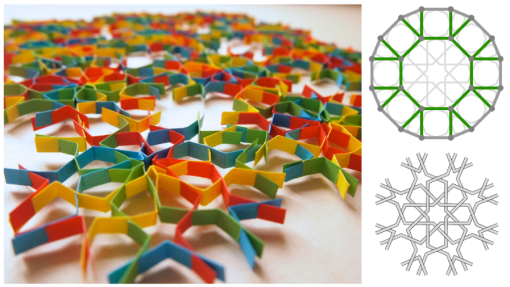Welcome to this week’s Math Munch!
For the 5th and final Thursday of June we will once again take a look at some of the goodness over on our facebook page, and oh my goodness what a huge load of goodness we have indeed! For an appetizer, how about this little visual problem posted by ThinkFun Games? (If you remind me in the comments, I’ll tell you the neat way I thought about solving it.)
 The shape consists of overlapped color circles. Which two colors have their total visible areas equal? (click to enlarge)
The shape consists of overlapped color circles. Which two colors have their total visible areas equal? (click to enlarge)
Now onto the main course. I have to show you this incredible new math art tool called SLICEFORM STUDIO. Click over and check out their gallery to begin with. Just gorgeous.

My first creation on SliceForm.com
There’s a tutorial page as well, but the best thing to do is probably just to start playing with the app itself. DIG IN! The site is sort of made for people who can use laser cutters to do the paper and stuff, but you can also just click “trace and export strips” and then color it in and export the image. On the right, you can see my first creation. Email yours to mathmunchteam@gmail.com and we’ll stick it in our readers’ gallery.
Alright, up next is an amazing mathematical artist by the name of Rinus Roelofs. (You might remember the paper project of his that we shared at new year.) Well, Rinus is just an unblievable and prolific maker of incredible and beautiful things. Check out his website. (He has two, I think)
I follow Rinus on facebook, and he’s always posting pictures of his works in progress, and they are stunning. First, check out this gallery of Interwoven Ring Patterns he recently posted. Then take a look at his timeline photos. Lots of overlapping patterns and Möbius shapes.

Finally, have you ever heard of Galaxy Puzzles? I hadn’t either, but you can find lots of them over on the wonderful puzzling site, krazydad. The puzzle begins with lots of dots, and your goal is to separate the dots by making enclosures that have 180 degree rotational symmetry. Print and play galaxy puzzles are available as well as an interactive online version. There are lots of other puzzles available as well, but I think Battleships is a pretty cool. You might give that a try too.
But wait, there’s more. With 5 Thursdays in a month, there’s just lots to share, so you also get some bonus stuff!
- A gallery of stunning images of “impossible figures”
- A mathematical poem (based on a Robert Frost classic)
- A video about some very cool new dice from The Dice Lab
That’s it for June. See you next time. Bon appetit!












